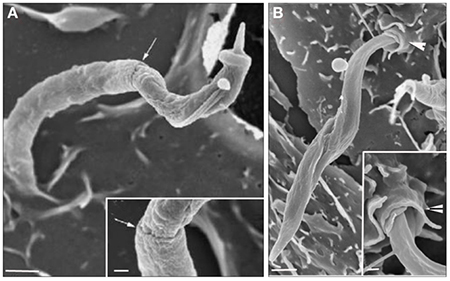
September 15, 2025 Puzzle Piece
Chagas Disease: Can Be Potentially Fatal
The
insects that spread the disease are known as ‘kissing bugs’ and have
been found in at least 32 states, spreading the parasite Trypanosoma
Cruzi.
An electron microscope image shows a Trypanosoma cruzi parasite, which
can be transmitted through Kissing Bugs and continues to spread,
creating Chagas Disease.
 According
to the study, released in September by the Centers for Disease Control
and Prevention (CDC), the disease may be considered endemic in the
United States because of “increasing evidence” that the parasite,
Trypanosoma cruzi, is being found more often in insects, domestic
animals, wildlife, and people, challenging the “nonendemic label” for
the United States.
According
to the study, released in September by the Centers for Disease Control
and Prevention (CDC), the disease may be considered endemic in the
United States because of “increasing evidence” that the parasite,
Trypanosoma cruzi, is being found more often in insects, domestic
animals, wildlife, and people, challenging the “nonendemic label” for
the United States.
“Several triatomine species are common in the southern United States,
where they transmit T. cruzi and invade human dwellings,” the
researchers wrote. “Wildlife, captive animals, and companion animals,
especially dogs, are commonly infected with T. cruzi parasites in this
region and serve as reservoirs.”
The CDC states the insects that spread the disease are known as “kissing
bugs.” These hematophagous insects (bloodsuckers) are found in the
southern portion of the United States. The insects have been found in at
least 32 states. Currently, the disease is considered endemic in 21
countries in the Americas.
Signs and Symptoms
Mayo Clinis says Chagas disease can cause health issues in people
decades after they are infected with the parasite, health officials
say. Many people do not know that they have been infected with the
disease but may enter a chronic infection phase that can lead to heart
or digestive system problems years later.
Symptoms of acute Chagas disease can include fever, body aches, fatigue,
headache, vomiting, diarrhea, a redness, or rash around the bug bite
area that may develop into an ulcer, and a swollen eyelid, the clinic
said. However, some patients do not develop any symptoms.
Mayo’s states, “Chronic Chagas disease may cause serious complications
that affect your heart, brain, and digestive tract,” the Mayo Clinic
said. “These can be life-threatening and may be something you may have
to manage for the rest of your life.” About 30 percent to 40 percent of
people infected with the parasite can develop a chronic infection.
Symptoms of a long-term infection can include heart palpitations,
shortness of breath, fainting, dizziness, chest pain, constipation,
heartburn, bloating, and issues with swallowing.
Case studies demonstrate chronic symptoms can also include cardiac
arrest, enlarged heart, heart failure, arrhythmia, enlarged esophagus,
or enlarged colon. Acute versions of the infection can cause
myocarditis—inflammation of the heart muscle—or brain inflammation.
Kissing bugs, which are sometimes called vampire bugs, include dozens of
different species that feed on the blood of certain animals. The CDC
report states that Triatoma sanguisuga, T. gerstaeckeri, T. protracta,
and T. rubida are the ones of most concern because they are most
commonly found in human dwellings.
The states that have been found to have the Kissing Bugs without the
report of Chagas are Nevada, Utah, Wyoming, Colorado, Nebraska,
Illinois, Indiana, Ohio, West Virginia, Pennsylvania, New Jersey, and
Delaware.
States that have been found to have local transmission of animal and
human cases of Chagas disease and kissing bugs include California,
Arizona, Texas, Louisiana, Missouri, and Tennessee, according to the
map.
States with cases of local transmission of Chagas in animals—not in
people—as well as reports of kissing bugs include New Mexico, Oklahoma,
Nebraska, Kentucky, Mississippi, Alabama, Georgia, Florida, South
Carolina, North Carolina, Virginia, and Maryland.
UCLA Says Disease ‘Can Be Deadly’
The World Health Organization estimates that about 7 million people
worldwide, primarily in Latin America, have the parasite infection that
causes the disease. According to the U.N. health body, Chagas disease
can be “curable if antiparasitic treatment is initiated early, in the
acute phase.” In its chronic stage, “treatment and follow up can
potentially prevent or curb disease progression and prevent
transmission, for instance, during pregnancy, and birth.”
Officials at the University of California–Los Angeles (UCLA) said in a
statement that an estimated 300,000 people in the United States have
Chagas, with more than 45,000 people in the Los Angeles area having the
disease. “Most people living with Chagas disease are unaware of their
diagnosis, often until it’s too late to have effective treatment,” UCLA
Health’s chief of infectious diseases, Judith Currier, said in the
statement.
Treatment Options
The CDC says Chagas disease can be treated with some antiparasitic
medications, although that treatment tends to work best when started
early. The medications include benznidazole, which the Food and Drug
Administration has approved to specifically treat the disease, as well
as nifurtimox, according to the agency.
Joanna Schaenman, an infectious diseases physician and researcher who
works with transplant patients, said in the UCLA statement that Chagas
patients sometimes require a heart transplant, although some can also
manage the condition with heart medication.
In Addition
Keeping ourselves healthy by all of the Six Steps to Wellness helps
prevent illness and using OHS nutrition strengthens the body for
Prevention and Healing. Using Opti-Para is wise with all of the
potential parasite exposure. Opti-Heart can be effective in supporting
heart stress for any reason.
Since 70-80% of the Immune System is in the gut, proper diet and OHS
nutraceuticals are helpful in prevention and healing protocols.
Homecoming 2026 in Tempe, AZ on January 22-25, 2026, with all the new research, nutrition, and developments.
Yours in Health and Wellness,
John W Brimhall, DC, BA, BS, FIAMA, DIBAK, Formulator, Patent Holder
(Only registered customers can rate)
There are no comments for this product.